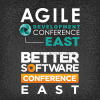Agile Development Conference & Better Software Conference East 2014

PRESENTATIONS
|
A Holistic View of Complex Systems and Organizational Change
One of the most misunderstood concepts in the agile community, complexity is often used to explain why we can’t predict anything or why there are no rules we can follow. Ironically, it is exactly this attitude that allows complexity to work against us. Al Shalloway discusses the true... |
|
|
A Very Large Enterprise Agile Transformation: Lessons Learned at Salesforce
When the agile consultants leave, how do you ensure that the enterprise agile transformation sticks, evolves, and grows throughout the organization? What challenges will you face? What support must be in place to address the challenges? Like software products, the real cost of an agile... |

Mike Register, Salesforce.com |
|
Agile Development Conference & Better Software Conference East 2014: EARS: The Easy Approach to Requirements Syntax
One key to specifying effective functional requirements is minimizing misinterpretation and ambiguity. By employing a consistent syntax in your requirements, you can improve readability and help ensure that everyone on the team understands exactly what to develop. John Terzakis provides... |

John Terzakis, Intel |
|
Agile Development Conference & Better Software Conference East 2014: Emergent Design: History, Concepts, and Principles
Software design is about change. A good design facilitates adding features—and adding new developers to the team. Yet any change to the code impacts design and could damage existing functionality. Without design idioms and practices, the code can degrade into a "big ball of spaghetti”... |

Rob Myers, Agile Institute |
|
Agile Development Conference & Better Software Conference East 2014: Seven Deadly Habits of Ineffective Software Managers
As if releasing a quality software project on time were not difficult enough, poor management of planning, people, and process issues can be deadly to a project. Presenting a series of anti-pattern case studies, Ken Whitaker describes the most common deadly habits—along with ways to avoid... |

Ken Whitaker, Leading Software Maniacs |
|
Agility at Scale: WebSphere’s Agile Transformation
In today's rapidly changing environment, organizations—both large and small—must quickly respond to shifting market requirements to remain competitive. To be successful, many are adopting agile development and continuous delivery methodologies to deliver software quickly, while keeping... |

Susan Hanson, IBM Software Group |
|
Applying Courtship Principles: Hiring for the Long Term
As managers, we tend to focus on improving our processes. But have you considered that good people—not processes—are really the foundation of high-quality software? Competent and skilled people—combined with good process—can consistently produce higher-quality software... |
Philip Lew, XBOSoft |
|
Assessing Agile Engineering Practices
Organizations are often reluctant to adopt the more challenging agile engineering practices—first seen together in Extreme Programming and later adopted by the Scrum Alliance as the Scrum Developer Practices. These practices are difficult to implement and sustain, and the benefits are... |

Rob Myers, Agile Institute |
|
Automating End-to-End Business Scenario Testing
Allstate Insurance had a problem. While thoroughly testing each of their more than thirty business systems, they were still failing to provide good service to their clients, agents, and internal customers. The reason was simple. Implementing end-to-end business processes requires more than... |

Sandra Alequin, Allstate Insurance and Monika Mehrotra, Infosys, Ltd. |
|
Avoiding Over Design and Under Design
The question of how much design to do up-front on a project is an engaging conundrum. Too much design often results in excess complexity and wasted effort. Too little design results in a poor architecture or insufficient system structures which require expensive rework and hurt more in the... |
|


